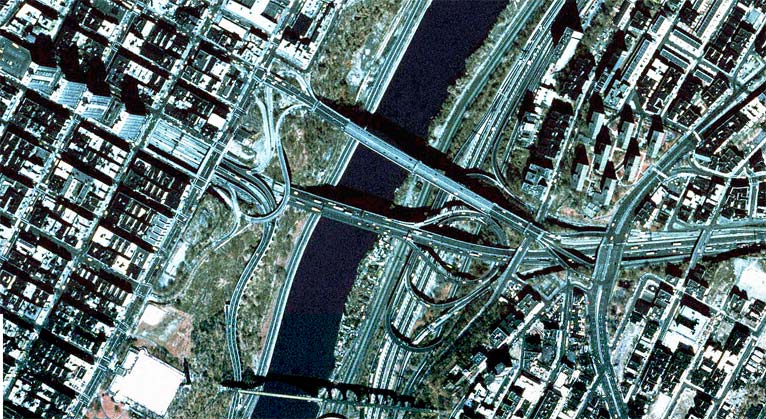Monday, 25 August 2003
 |
 |
Orientation: This photo falls directly to the east of last week's. The Borough of Manhattan is at left and the Borough of Bronx is at right, on either side of the Harlem River. I-95, still overlapped by US 1, enters at top left on the Trans-Manhattan Expressway, roofed by a group of apartment buildings. It crosses the Alexander Hamilton Bridge and becomes the Cross Bronx Expressway. Although this road is aligned east and west, signage for I-95 and US 1 are given as north and south, respectively, to reflect their orientation on the national scale. I-87 runs bottom to top on the Major Deegan Expressway, just east of the river and a branch of the Metro-North Commuter Railroad.
Spanning the river just north of the Alexander Hamilton Bridge is the Washington Bridge (not to be confused with the George Washington Bridge over the Hudson River). A continuation of Manhattan's West 181st Street, the bridge connects to local streets in both boroughs, and to I-95 at both ends. At bottom is High Bridge, a former water supply structure and pedestrian bridge, now closed.
The large curving street in the Bronx is Dr. Martin Luther King Boulevard (familiarly known as University Avenue) north of the expressway, and Edward L. Grant Highway south of it. University Avenue branches to the southwest, toward High Bridge. In Manhattan, Amsterdam Avenue runs from bottom to top high above the river, while the Harlem River Drive runs hard by the shore. A viaduct climbs the hillside from the Harlem River Drive to the Trans-Manhattan Expressway.
Exit numbers: Exit 2 from I-95, northbound only, is for the Harlem River Drive and Amsterdam Avenue. Exits 3N and 3S are for the Major Deegan Expressway (I-87); southbound, this exit also serves Amsterdam Avenue via the Washington Bridge. From I-87, Exits 7N and 7S are for I-95 north and south. From the Harlem River Drive, Exit 24 is for I-95 southbound (George Washington Bridge), Amsterdam Avenue and West 179th Street.
The interchange: The Highbridge Interchange at the west end of the Alexander Hamilton Bridge features a spur viaduct from the Harlem River Drive feeding the George Washington Bridge via I-95 southbound. The divided roadways of this spur pass under Amsterdam Avenue before meeting the Trans-Manhattan Expressway, merging between the inner and outer roadways of the latter. Also, a ramp off of Amsterdam Avenue meets the viaduct up the middle, serving traffic to and from the south on the Harlem River Drive. Two other ramp pairs branch from the spur as it weaves into I-95: these provide local traffic connections from Amsterdam Avenue and from the Washington Bridge directly to the George Washington Bridge (via I-95), and vice versa. The inner and outer roadways of I-95 merge together just west of the Alexander Hamilton Bridge. Incidentally, the Alexander Hamilton Bridge is the only prominent crossing in New York City under the jurisdiction of the New York State Department of Transportation.
In the 1950s, the Washington Bridge ramps connected with tunnels under West 178th and West 179th Streets. These tunnels still exist, and clearly visible here is a piece of the old ramp from the 178th Street tunnel to the Washington Bridge, cut into the hillside between Amsterdam Avenue and the modern ramp. Another old ramp stub is visible along the viaduct, halfway down on the southbound side.
In the Bronx, I-87 and I-95 meet at a full 8-ramp interchange. Because I-95 is elevated high above I-87, and because of the proximity to the river and railroad, the ramps are almost entirely elevated and very tightly looped. In particular, the ramps from I-95 northbound to I-87 southbound and from I-87 southbound to I-95 southbound travel through 270 degrees of a circle, whereas in most cases these would be simple 90-degree turns. The interchange ramps are for the most part too narrow for modern traffic demands, especially since most of the city's truck traffic is relegated to the Interstates. Combining large trucks and heavy traffic with tight curves and inadequate lane capacity make this interchange one of the most congested in the city. On the other hand, it is among the most impressive, with its distinctive blue paint scheme and its imposing tangle of elevated ramps.
Adding to the visual clutter from above, Sedgwick Avenue runs through the interchange at ground level, just east of I-87. Also, the I-95 southbound offramp is extended eastward and combined with the ramp to the Washington Bridge, from which there is a corresponding onramp. These ramps, together with those on the Manhattan end, make the bridge a good alternate for passenger vehicles on I-95 to bypass the Alexander Hamilton Bridge and the I-87 interchange, although it provides no relief for the infamous congestion farther east on the Cross Bronx Expressway. The Washington Bridge also has an outer pair of ramps to and from Dr. Martin Luther King Boulevard and Edward L. Grant Highway.